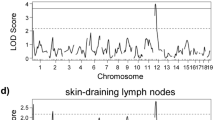Abstract.
An important approach to understanding complex diseases is to reduce them into well-characterized subphenotypes that are under monogenic control. One such example is Bordetella pertussis toxin-induced histamine sensitization in mice, a subphenotype of experimental allergic encephalomyelitis and experimental allergic orchitis. This subphenotype is controlled by a single locus, Bphs, previously mapped to a 33 cM region on mouse Chromosome (Chr) 6. We achieved considerable reduction of this candidate region and constructed a YAC contig across the refined interval. Our results demonstrate that Bphs is located between D6Mit151 and a newly developed marker, EC108RR, a region containing a small cluster of genes belonging to the TNF receptor superfamily. Sequence and quantitative analysis of the candidate gene, tumor necrosis factor receptor 1 (Tnfr1, p55), indicates that it is unlikely to be Bphs. However, the location of Bphs, together with physiologic effects it shares with Tnfr1 activation, suggest that Bphs may prove to be another member of the TNF receptor superfamily.
Similar content being viewed by others
Author information
Authors and Affiliations
Additional information
Received: 11 February 1999 / Accepted: 26 April 1999
Rights and permissions
About this article
Cite this article
Meeker, N., Stafford, A., Lunceford, J. et al. Physical mapping of the autoimmune disease susceptibility locus, Bphs: co-localization with a cluster of genes from the TNF receptor superfamily on mouse Chromosome 6. 10, 858–863 (1999). https://doi.org/10.1007/s003359901104
Issue Date:
DOI: https://doi.org/10.1007/s003359901104




